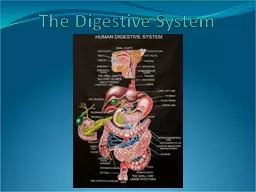

The digestive system is used for breaking down food into nutrients which then pass into the circulatory system and are taken to where they are needed in the body Introduction There are four stages to food digestion ID: 681081
Download Presentation The PPT/PDF document "The Digestive System Introduction" is the property of its rightful owner. Permission is granted to download and print the materials on this web site for personal, non-commercial use only, and to display it on your personal computer provided you do not modify the materials and that you retain all copyright notices contained in the materials. By downloading content from our website, you accept the terms of this agreement.
Slide1
The Digestive SystemSlide2
Introduction
The digestive system is used for breaking down food into nutrients
which then pass into the circulatory system and are taken to where they are needed in the body.Slide3
Introduction
There
are four stages to food digestion:
Ingestion
: taking in food
Digestion
: breaking down food into nutrientsAbsorption: taking in nutrients by cells and circulatory systemEgestion: removing any leftover wastesSlide4
The Human Digestive System
Begins when food enters the mouth.
It is physically broken down by the teeth
.
It is begun to be chemically broken down by an enzyme in saliva that breaks down carbohydrates.Slide5
The Human Digestive System
The tongue moves the food around until it forms a ball called a
bolus
.
The bolus is passed to the
pharynx
(throat) and the epiglottis makes sure the bolus passes into the esophagus and not down the windpipe!Slide6
The Human Digestive System
The bolus passes down the esophagus
by peristalsis
.
Peristalsis
is a wave of muscular contractions that push the bolus down towards the stomach.Slide7
The Human Digestive System
The stomach
has folds called
rugae
and is a big muscular pouch which churns the bolus (
Physical Digestion
) and mixes bolus with gastric juice, stomach acid, and enzymes then churns it.Slide8
The Human Digestive System
The
acid
kills off any invading bacteria or viruses.
The enzymes help break down proteins and lipids = Chemical Digestion
.
The mucus protects the lining of the stomach from being eaten away by the acid.Slide9
The Human Digestive System
The stomach absorb some medicines (i.e. aspirin), and water
The digested bolus is now called
chyme
and enters small intestine.Slide10
The Human Digestive System
Chyme
goes into small intestine (SI).
nutrients absorption occurs in SI .
The liver and pancreas adds more enzymes
SI is broken down into three parts:Slide11
The Human Digestive System
Duodenum
Bile
, produced in the
liver
but stored in the
gall bladder, enters through the bile duct. It breaks down fats.The pancreas secretes pancreatic juice to reduce the acidity of the chyme. Slide12
The Human Digestive System
Jejunum
The jejunum is where the majority of absorption takes place.
It has tiny fingerlike projections called
villi
lining it, which increase the surface area for absorbing nutrients.Slide13
The Human Digestive System
Each villi itself has tiny fingerlike projections called
microvilli
, which further increase the surface area for absorption.Slide14
Blood going to the Small IntestineThe circulatory system sends blood to the digestive system (especially the small intestine) to carry away the digested nutrients to other parts of the body.
Your muscles, bones, skin, organs (in essence, everything) needs nutrients from the digested food. It is your blood that delivers all of these nutrients. Slide15
Circulatory Sys.
This slide shows how blood enter the microvilli to carry nutrients away to other parts of the body.
The Hormone GastrinSlide16
The circulatory system’s role…
What percentage of the blood leaving heart goes directly to the digestive system?
The Hormone GastrinSlide17
The Human Digestive System
Ileum
The last portion of the small intestine is the ileum,
which has fewer villi and
basically compacts the leftovers to pass into the large intestine.Slide18
The Human Digestive System
The
large intestine
(or
colon
) is used to
absorb water from the waste material leftover and to produce vitamin K and some B vitamins using the helpful bacteria that live here.Slide19
The Human Digestive System
All leftover waste is compacted and stored at the end of the large intestine called the
rectum
.Slide20
Digestion and Homeostasis
The endocrine, nervous, digestive and circulatory systems all work together to control digestion.
Before we eat, smelling food releases
saliva
in our mouths and
gastrin
in our stomachs which prepares the body for a snack.
The Hormone GastrinSlide21
Digestion and Homeostasis
A large meal activates receptors that churn the stomach and empty it faster.
If the meal was high in fat, digestion is slowed, allowing time for the fat to be broken down.
Hence why we feel fuller after eating a high fat meal.